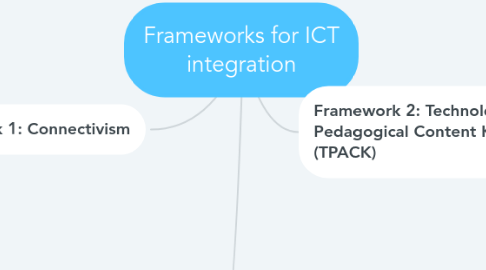
1. Framework 1: Connectivism
1.1. Connectivism is the integration of principles explored by chaos, network, and complexity and self-organization theories.
1.1.1. One disadvantage of this framework is that critics argue that Connectivism is a pedagogical approach rather than a learning theory.
1.1.2. One advantage of Connectivism is that it embraces individual perspectives and diversity of opinions, theoretically providing for no hierarchy in the value of shared knowledge.
2. Framework 2: Technological Pedagogical Content Knowledge (TPACK)
2.1. This framework consists of effective teaching, it requires teachers to have a deep understanding of three bodies of knowledge: Content Knowledge (CK), Pedagogical Knowledge (PK) and Pedagogical Content Knowledge.
2.1.1. An advantage of this framework is that it provides strategies for planning and implementing educational technology
2.1.2. A disadvantage is that TPACK is not designed to be an entire package or the full view of integrating technology.
3. Framework 3: Bloom’s Digital Taxonomy
3.1. Bloom’s Digital Taxonomy informs instructors how to use technology and digital tools to facilitate student learning experiences and outcomes
3.1.1. Bloom's Taxonomy helps educators identify the intellectual level at which individual students are capable of working. It also helps them ask questions and create instruction aimed at critical thinking by striving to reach the top three levels of analysis, synthesis and evaluation with students ready for those levels.
3.1.2. Concerns of Blooms Taxonomy is that the construction of the pyramid places knowledge/remembering at the bottom of the stack. It is therefore seen as least important, as a “lower-level” process that should be avoided as much as possible to give students more “higher-level” skills.
